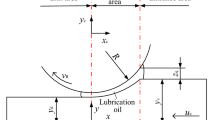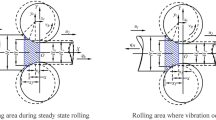Abstract
Purpose
This study investigates a vibration system considering friction force and external excitation. In particular, when the direction of the friction force is at an oblique angle along the horizontal and vertical directions, the influences of dry friction on the system dynamics are discussed.
Methods
The two-degree-of-freedom dynamical model with dry friction and external excitation is established. The piecewise analytical solution corresponding to different phases is deduced based on theoretical method, the complicated dynamic behaviors are investigated by numerical simulations.
Results
The results indicate that there is no vibration of the system when external excitation does not act in either the horizontal or vertical direction, but system vibration remains when external excitation acts in both the vertical direction and horizontal direction. As parameters change largely, there exist rich symmetric and asymmetric motion, quasi-periodic motion, and chaos, and the system stability is discussed when the system parameters change within a certain range based on the Lyapunov exponent method.







Similar content being viewed by others
References
Den Hartog JP (1931) Forced vibrations with combined coulomb and viscous friction. Trans Am Soc Mech Eng 53:107–115
Ferri AA, Dowell EH (1984) Frequency domain solutions to multi-degree-of-freedom dry friction damped systems. J Sound Vib 124:207–224
Feeny BF, Moon FC (1994) Chaos in a forced oscillator with dry friction: experiments and numerical modeling. J Sound Vib 170:303–323
Galvanetto U (2001) Some discontinuous bifurcations in a two-block stick-slip system. J Sound Vib 248:653–669
Galvanetto U, Steven RB (1998) Computational techniques for nonlinear dynamics in multiple friction oscillators. Comput Methods Appl Mech Eng 163:373–382
Galvanetto U, Magri L (2013) On the use of the theory of dynamical systems for transient problems. Nonlinear Dyn 74:373–380
Natsiavas S (1998) Stability of piecewise linear oscillators with viscous and dry friction damping. J Sound Vib 217:507–522
Albert CJL, Brandon CG (2006) Stick and non-stick periodic motions in periodically forced oscillators with dry friction. J Sound Vib 291:132–168
Batako ADL, Piiroinen PT (2008) Friction-driven vibro-impact system for percussive-rotary drilling: a numerical study of the system dynamics. Proc Inst Mech Eng Part C J Mech Eng Sci 222:1925–1934
Cone KM, Zadoks RI (1995) A numerical study of an impact oscillator with the addition of dry friction. J Sound Vib 188:659–683
Zhai HM, Ding Q (2013) Stability and nonlinear dynamics of a vibration system with oblique collisions. J Sound Vib 332:3015–3031
Xiang WWK, Yan SZ, Wu JN (2015) A comprehensive method for joint wear prediction in planar mechanical systems with clearances considering complex contact conditions. Sci China Technol Sci 58:86–96
Li JL, Yan SZ, Guo F et al (2012) Effects of damping, friction, gravity, and flexibility on the dynamic performance of a deployable mechanism with clearance. Proc Inst Mech Eng Part C J Mech Eng Sci 8:1791–1803
Yan SZ, Xiang WK, Zhang L (2015) A comprehensive model for 3D revolute joints with clearances in mechanical systems. Nonlinear Dyn 80:309–328
Klaus Z, Zeidis I (2011) Dynamical behavior of a mobile system with two degrees of freedom near the resonance. Acta Mech Sin 27:7–17
Db RN, Nejad SN, Kabganian M et al (2012) Adaptive control of a legged capsular microrobot based on Lyapunov stability criteria. Proc Inst Mech Eng Part C J Mech Eng Sci 226:887–899
Silvio LT, Ibere LC (2004) Calculation of Lyapunov exponents in systems with impacts. Chaos, Solitons Fractals 19:569–579
Stefanski A (2000) Estimation of the largest Lyapunov exponent in systems with impacts. Chaos, Solitons Fractals 11:2443–2451
Wolf A, Swift JB, Swinney HL et al (1985) Determining Lyapunov exponents from a time series. Physica D 3:285–317
Packard NH, Crutchfield JP, Farmers JD et al (1980) Geometry from a time series. Phys Rev Lett 45:712–716
Cellucci CJ, Albano AM, Rapp PE (2003) Comparative study of embedding methods. Phys Rev E Stat, Nonlinear, Soft Matter Phys 6:210–224
Acknowledgements
This work is supported by the National Natural Science Foundation of PRC (Grant no. 11362020, Grant no. 51265048).
Author information
Authors and Affiliations
Corresponding author
Rights and permissions
About this article
Cite this article
Liao, J., Zhang, Y., Luo, S. et al. Numerical Study of Dry Friction Vibration System with Oblique Friction Force. J. Vib. Eng. Technol. 7, 1–9 (2019). https://doi.org/10.1007/s42417-018-0072-x
Received:
Accepted:
Published:
Issue Date:
DOI: https://doi.org/10.1007/s42417-018-0072-x




